Martha and George Carpenter have been in the catfish business for the past three years. George was a machinist with the Westinghouse Corporation in Pensacola. He is president of the Northwest Florida Catfish Association. Northwest Florida is distinguished by several factors which enable farms to produce more catfish per acre than any other domestic market. Excellent water from deep water wells and the long growing season establish a platform in a nine acre pond to sustain 7000 fish per acre. Harvesting takes place four times a year. Each harvest yields at least 30,000 tons. The most recent harvest totaled 54,000. The operating cost for an 8 - 10 acre pond is about $17,000.00 per year. Because of the excellent growing conditions, area leaders are considering seeking funding for a processing plant which would afford the catfish farming community a higher price per pound for their fish. It would also lower the cost of shipping.
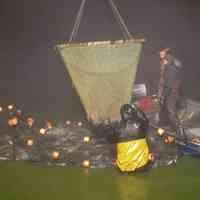
Oak Grove:
Carpenters Catfish Farm
 Oak Grove: Carpenters Catfish Farm
Oak Grove: Carpenters Catfish Farm
Bowling Green, FL
-
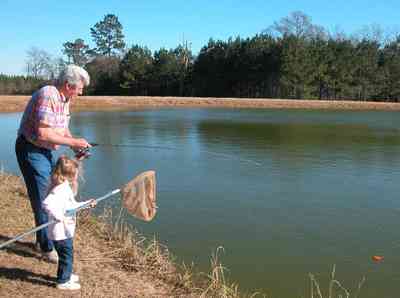 George Carpenter's granddaughter, Grace assists Dave Daughtry as he hooks a large catfish.
George Carpenter's granddaughter, Grace assists Dave Daughtry as he hooks a large catfish. -
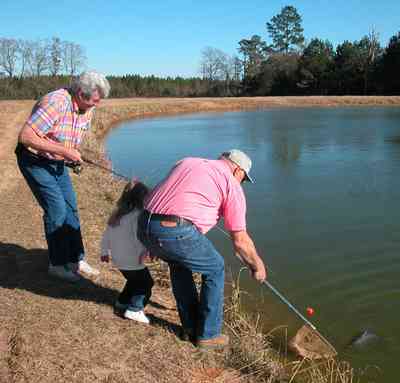 George comes to the rescue and lands the four and one-half pound catfish.
George comes to the rescue and lands the four and one-half pound catfish. -
 Grace takes a rest with her mother, Kaye Perry, George and Martha's daughter.
Grace takes a rest with her mother, Kaye Perry, George and Martha's daughter. -
 Extracting the hook is a delicate operation. Dave proceeds carefully, grasping the fish behind the gills while being careful to avoid getting stuck by the spiny backfin.
Extracting the hook is a delicate operation. Dave proceeds carefully, grasping the fish behind the gills while being careful to avoid getting stuck by the spiny backfin. -
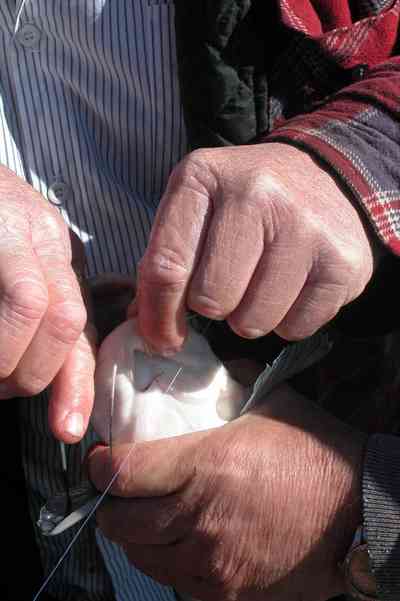 Donnie Waters is extracting the hook from the mouth of the catfish with the assistance of George Carpenter.
Donnie Waters is extracting the hook from the mouth of the catfish with the assistance of George Carpenter. -
 Each catfish is weighed. The average catfish costs $1.50 per pound when the fish is caught at the pond.
Each catfish is weighed. The average catfish costs $1.50 per pound when the fish is caught at the pond. -
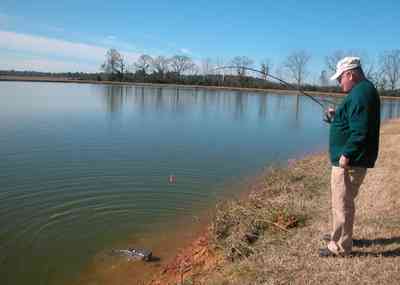 Mayor Bennie Barnes hooks a large catfish. He and Donnie Waters are planning a fish fry for Margorie Waters who is retiring from her job with the City of Century. It takes about an hour for the Mayor and Donnie to catch 20 fish.
Mayor Bennie Barnes hooks a large catfish. He and Donnie Waters are planning a fish fry for Margorie Waters who is retiring from her job with the City of Century. It takes about an hour for the Mayor and Donnie to catch 20 fish. -
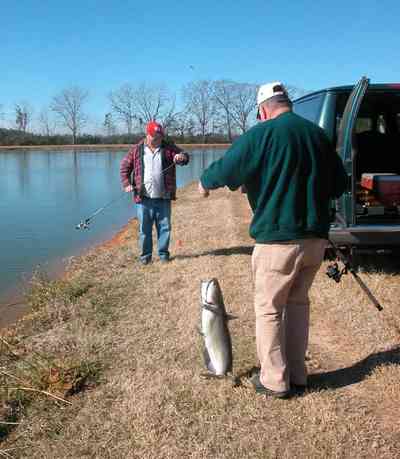 Mayor Barnes carries his fish to the scales for weigh-in.
Mayor Barnes carries his fish to the scales for weigh-in. -
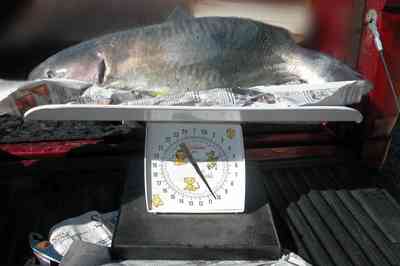 Mayor Barnes has the prize catch of the day.
Mayor Barnes has the prize catch of the day. -
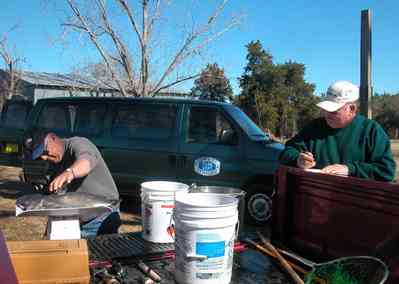 Mayor Barnes records the weight of his prize catch just before it is cleaned.
Mayor Barnes records the weight of his prize catch just before it is cleaned. -
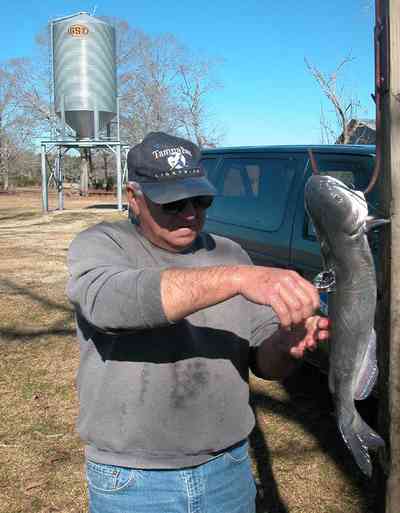 George Carpenter begins a demonstration of cleaning catfish by cutting off the spiny central fin.
George Carpenter begins a demonstration of cleaning catfish by cutting off the spiny central fin. -
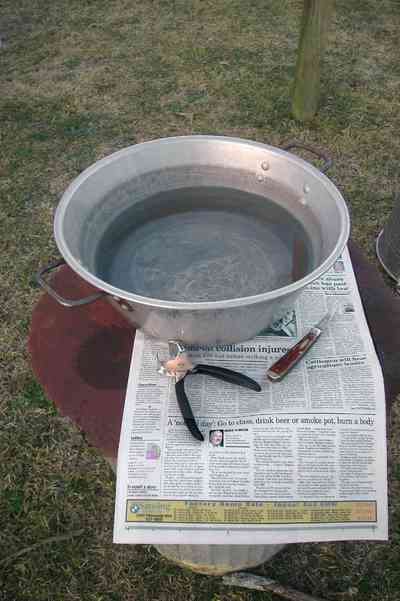 George lays out his catfish cleaning tooks, a gripper to strip the skin off the catfish and a fillet knife.
George lays out his catfish cleaning tooks, a gripper to strip the skin off the catfish and a fillet knife. -
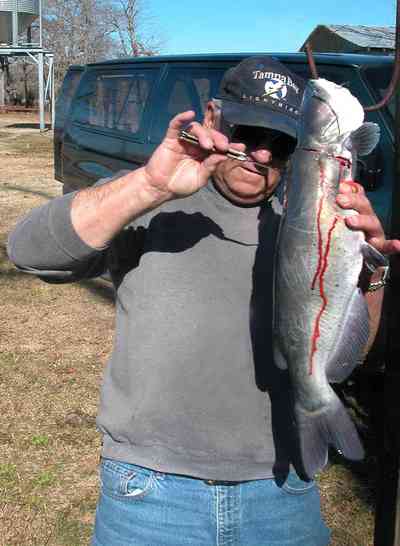 Catfish are skinned. The tough outer membrane is separated beginning with an incision at the head.
Catfish are skinned. The tough outer membrane is separated beginning with an incision at the head. -
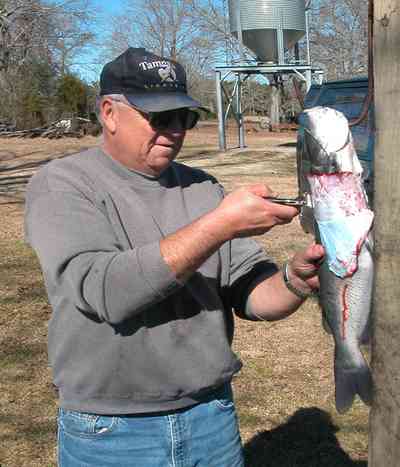 The skin is separated by pulling downward with grippers.
The skin is separated by pulling downward with grippers. -
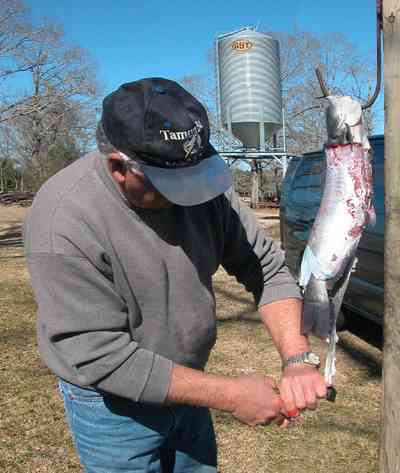 The silo in the background holds 15 tons of catfish food. Catfish food is fed in pellet form. It is a high protein diet composed of fish meal, soybeans, corn, and wheat. In the summer, the catfish at the Carpenter pond consume a ton of food each day.
The silo in the background holds 15 tons of catfish food. Catfish food is fed in pellet form. It is a high protein diet composed of fish meal, soybeans, corn, and wheat. In the summer, the catfish at the Carpenter pond consume a ton of food each day. -
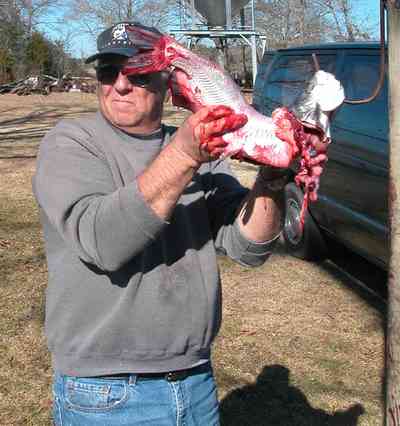 The body is separated from the head, leaving the entrails attached to the head.
The body is separated from the head, leaving the entrails attached to the head. -
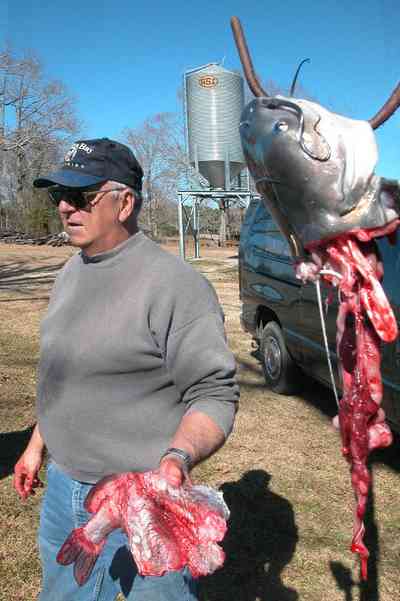 The fillet remaining weighs about 65% of the total weight of the fish.
The fillet remaining weighs about 65% of the total weight of the fish. -
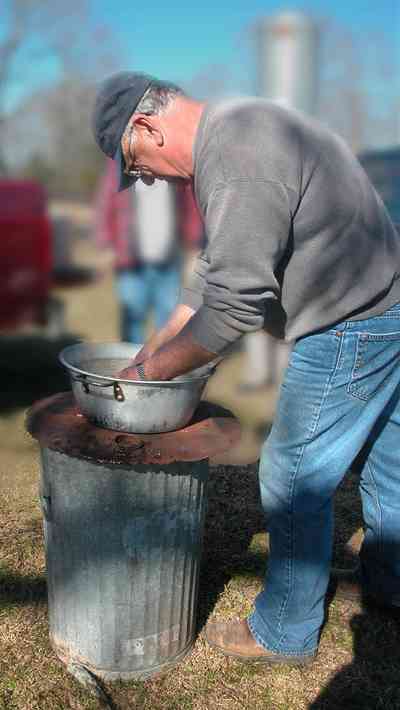 The fillet is cleaned in a pan of fresh water.
The fillet is cleaned in a pan of fresh water. -
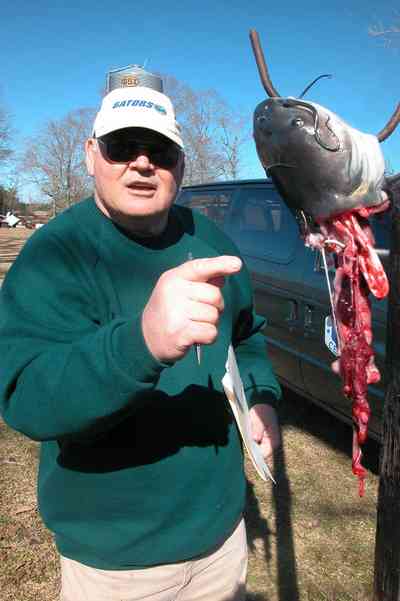 Mayor Barnes examines the remains of his prize catch.
Mayor Barnes examines the remains of his prize catch. -
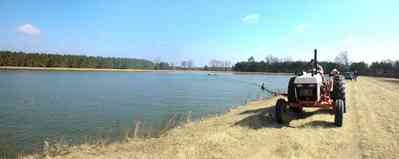 The catfish harvest begins by slowly seining the pond, beginning at one end with two tractors dragging the net, one on each side.
The catfish harvest begins by slowly seining the pond, beginning at one end with two tractors dragging the net, one on each side. -
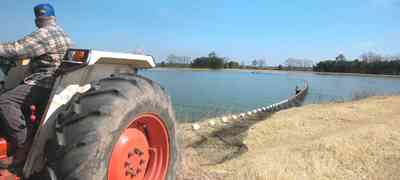 George drags one end of the seine net.
George drags one end of the seine net. -
 In this panorama of the pond, one man can be seen on right of the photograph. His job is to hold down the mud line so that the fish cannot escape under the seine net.
In this panorama of the pond, one man can be seen on right of the photograph. His job is to hold down the mud line so that the fish cannot escape under the seine net. -
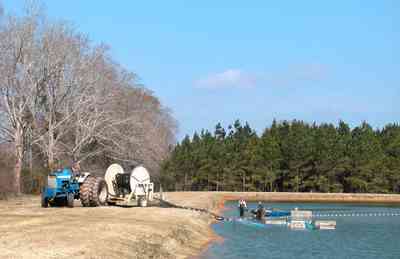 The larger tractor hauls a reel on which the seine net is slowly rewound.
The larger tractor hauls a reel on which the seine net is slowly rewound. -
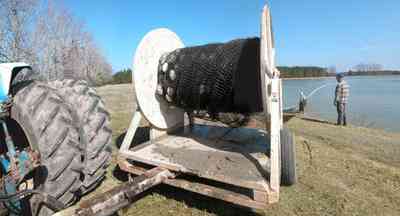 George Carpenter watches the seine net gradually close a small circle on the west bank of the pond.
George Carpenter watches the seine net gradually close a small circle on the west bank of the pond. -
 The two harvesters in the lower frame are attaching "the sock" which is used to grade the fish.
The two harvesters in the lower frame are attaching "the sock" which is used to grade the fish. -
 The fish are contained in a narrow area, defined by the buoys on the seine net.
The fish are contained in a narrow area, defined by the buoys on the seine net. -
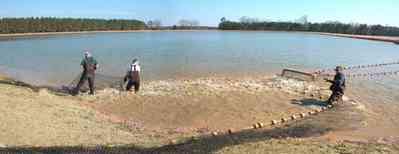 The trapped catfish swirl in the muddy water of the seine net.
The trapped catfish swirl in the muddy water of the seine net. -
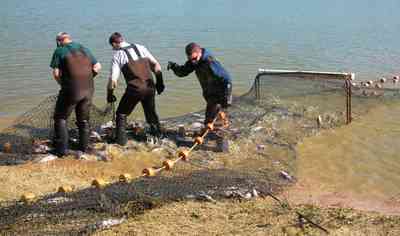 The fish are being driven into the sock. Small fish can escape through the netting while catfish 3 pounds and above remain in the sock. The grading process takes about 24 hours.
The fish are being driven into the sock. Small fish can escape through the netting while catfish 3 pounds and above remain in the sock. The grading process takes about 24 hours. -
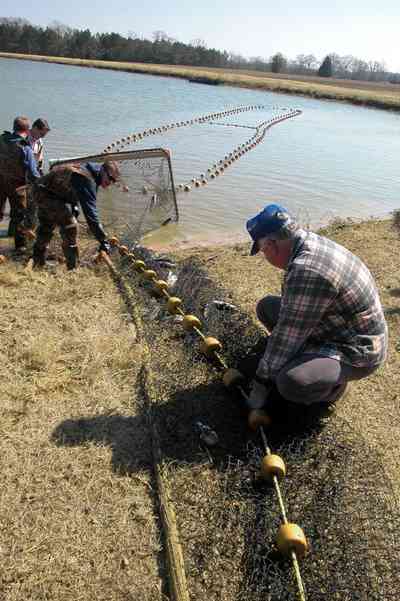 George rescues catfish that are caught in the seine net..
George rescues catfish that are caught in the seine net.. -
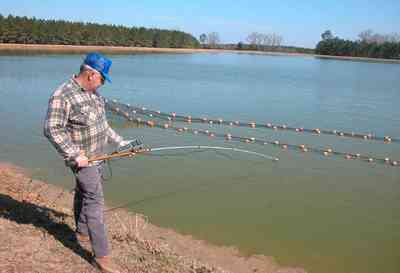 George is measuring the oxygen content of the water. This is an important task done as many as four times during a 24-hour period. The water is aerated at critical times. The sock will remain in place for 24 hours while the small fish escape the net.
George is measuring the oxygen content of the water. This is an important task done as many as four times during a 24-hour period. The water is aerated at critical times. The sock will remain in place for 24 hours while the small fish escape the net. -
 This specatular sunset can be seen from the Carpenter's kitchen window.
This specatular sunset can be seen from the Carpenter's kitchen window. -
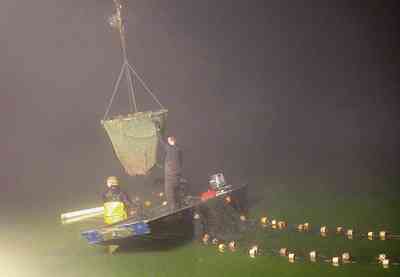 The loading basket has a trap door in the bottom.
The loading basket has a trap door in the bottom. -
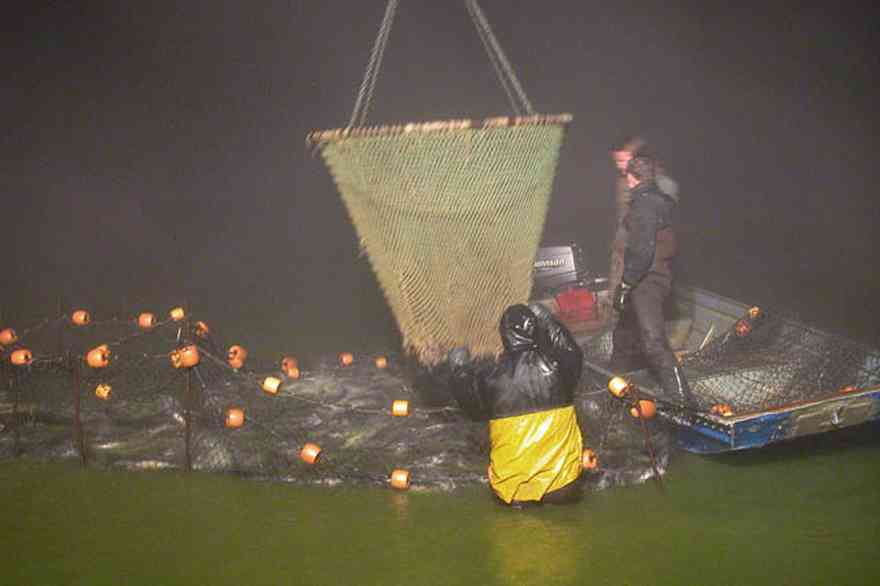 The basket is lowered into the teeming mass of catfish.
The basket is lowered into the teeming mass of catfish. -
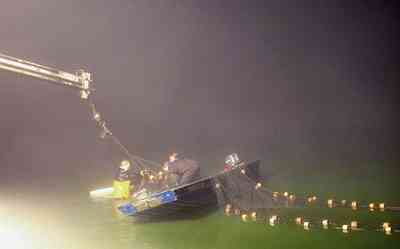 A boom truck will pick up the basket and load the fish into live wells on the truck.
A boom truck will pick up the basket and load the fish into live wells on the truck. -
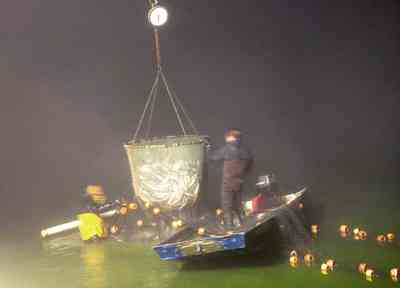 There is about 3,500 pounds per basket or 1,167 fish are retrived with each scoop.
There is about 3,500 pounds per basket or 1,167 fish are retrived with each scoop. -
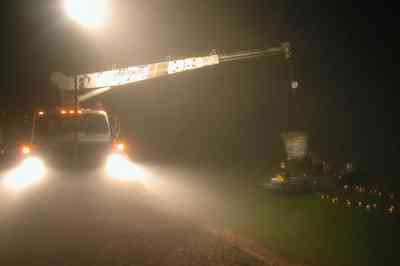 There are no chemicals used in the pond. it is a totally controlled environment. A sample fish is sent to the processing plant for assessment. Tasters at the plant decide when the fish are ready for harvest. A select few fish from each load are ground up and anaylzed for chemicals by the USDA.
There are no chemicals used in the pond. it is a totally controlled environment. A sample fish is sent to the processing plant for assessment. Tasters at the plant decide when the fish are ready for harvest. A select few fish from each load are ground up and anaylzed for chemicals by the USDA. -
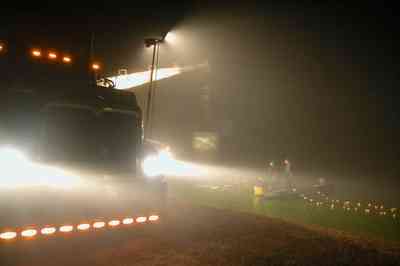 The taste of the fish depends on the quality of feed and water conditions. With the depletion of fish in the sea, catfish farming is becoming a growing industry.
The taste of the fish depends on the quality of feed and water conditions. With the depletion of fish in the sea, catfish farming is becoming a growing industry. -
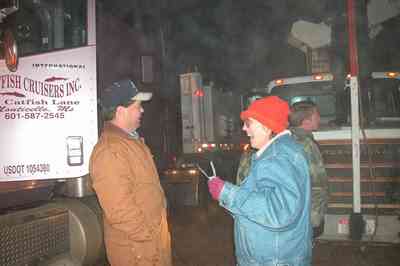 Martha and George receive the good news about the total weight of the harvest. This evening's catch was 22,000 pounds. Combined with the previous week, the total catch for the pond was 54,000 pounds or approximately 18,000 three-pound catfish.
Martha and George receive the good news about the total weight of the harvest. This evening's catch was 22,000 pounds. Combined with the previous week, the total catch for the pond was 54,000 pounds or approximately 18,000 three-pound catfish. -
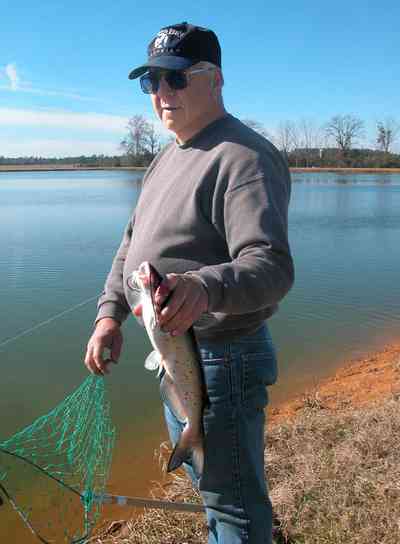 George Carpenter holds a 3 pound catfish which is an average size for the pond.
George Carpenter holds a 3 pound catfish which is an average size for the pond. -
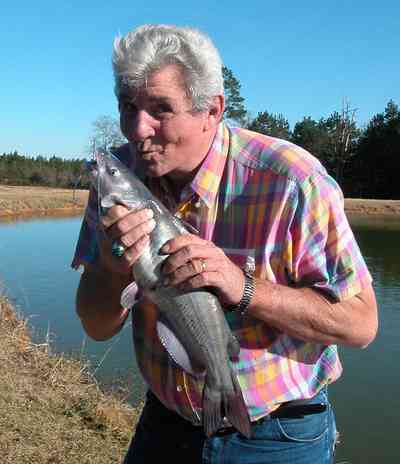 Dave Daughtry is excited to catch a 4 1/2 pound catfish.
Dave Daughtry is excited to catch a 4 1/2 pound catfish. -
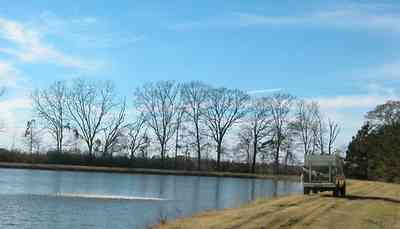 The feeding machine is mounted in the back of a pickup truck. Feed is sprayed about 20 feet over the pond. The small pellets are snapped up by the catfish. During the summer season, the fish can eat one ton of food per day.
The feeding machine is mounted in the back of a pickup truck. Feed is sprayed about 20 feet over the pond. The small pellets are snapped up by the catfish. During the summer season, the fish can eat one ton of food per day. -
 After the fish have graded themselves, the harvest begins. It usually takes place at night. The fish travel better at night and arrive at the processing plant early in the morning. There are six live wells on the truck that are injected with oxygen, ensuring that the catfish will arrive in excellent condition.
After the fish have graded themselves, the harvest begins. It usually takes place at night. The fish travel better at night and arrive at the processing plant early in the morning. There are six live wells on the truck that are injected with oxygen, ensuring that the catfish will arrive in excellent condition.
 One Tank of Gas
One Tank of Gas